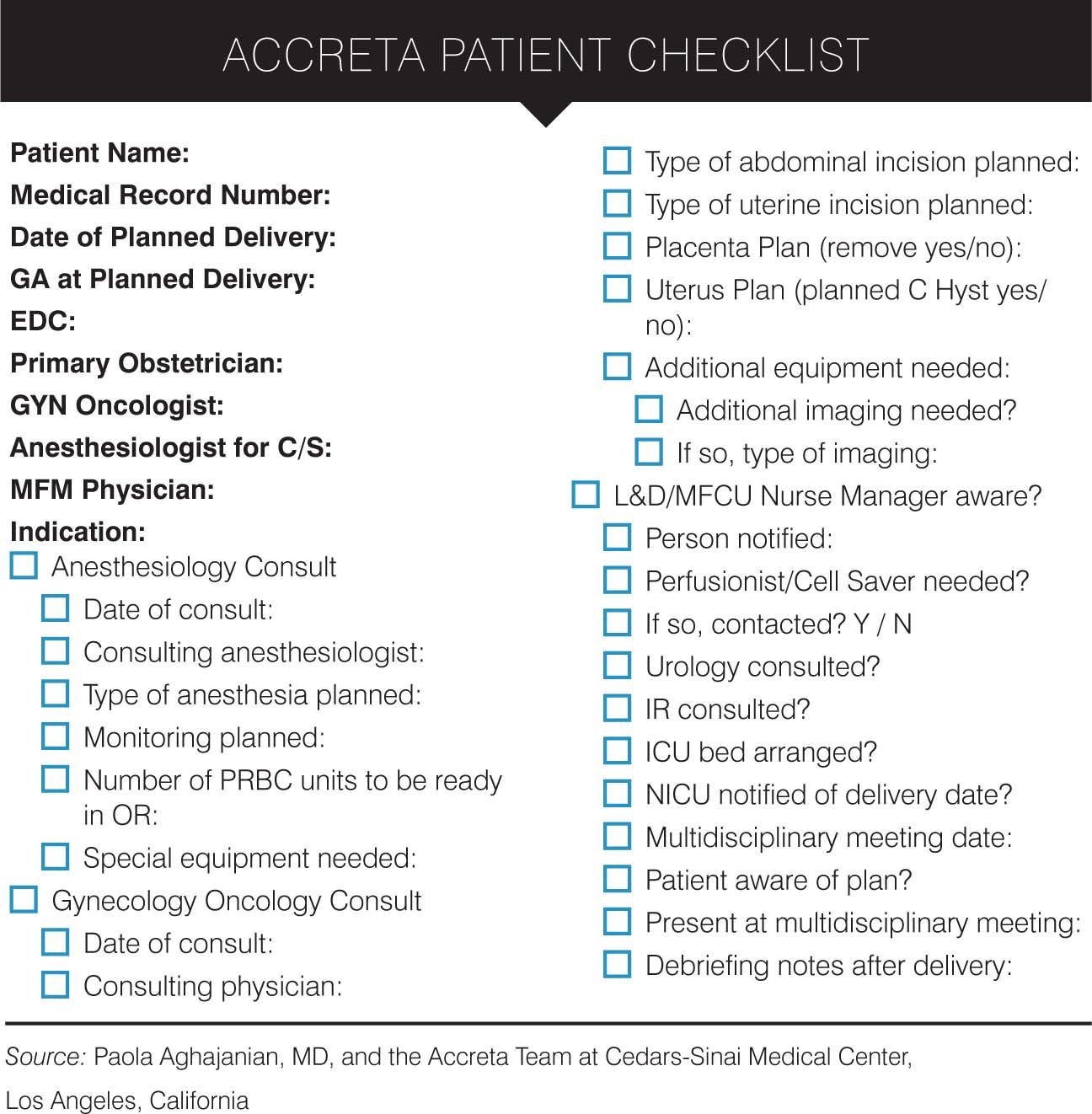Managing accreta takes a team
Facilities with accreta teams are working across disciplines to help patients.
A 2013 survey of ob/gyns showed that care of women who have or are at risk of placenta accreta varies widely.1 Only one quarter of physicians polled reported that they referred patients with suspected accreta to centers of excellence with multidisciplinary care teams. Yet maternal morbidity is reduced when women with the condition deliver in a tertiary care hospital with such a team, according to a retrospective study of placenta accreta cases in Utah.2
Accreta centers of excellence typically center around a multidisciplinary team with access to an intensive care unit and facilities and blood services. One such team, at Cedars-Sinai Medical Center, is directed by Paola Aghajanian, MD, who provided the accreta checklist below.

Paola Aghajajian, MD
The mission of the team, formed in 2014, is to provide coordinated, multidisciplinary management of patients with suspected accreta. The core team managing a patient includes a gynecologic oncologist, obstetric anesthesiologists, nursing leadership, and the woman’s primary obstetrician. If necessary, specialists from interventional radiology and the blood bank also are included.

A pregnant patient suspected of having accreta meets with individual members of the Accreta Team on an outpatient basis. Next, a multidisciplinary meeting of the team is convened to discuss and agree upon a plan of care. Then the team completes the accreta checklist, which is emailed to all physicians, nurses, and laboratory technicians on the general Accreta Team in preparation for the patient’s delivery. The checklist ensures that consistent care is provided for suspected accreta and that all team members are aware of the plan for a specific patient, should she present for delivery earlier than is anticipated.
A multi-institution consortium aimed at sharing data on accreta and better understanding and managing the condition is under way.3 Accreta teams from Columbia University Medical Center, Stanford University School of Medicine, and the University of Utah School of Medicine are among those participating in the effort. A tissue bank of normal and adhesive placenta samples is being created and will be tested for genetic or molecular signatures of abnormal invasiveness.4 Data from women with accreta also will be analyzed to determine how different management techniques impact patient outcomes.
REFERENCES
1. Wright JD, Silver RM, Bonanno C, et al. Practice patterns and knowledge of obstetricians and gynecologists regarding placenta accreta. J Matern Fetal Neonatal Med. 2013;26(16):1602-1609.
2. Eller AG, Bennett MA, Sharshiner M, et al. Maternal morbidity in cases of placenta accreta managed by a multidisciplinary care team compared with standard obstetric care. Obstet Gynecol. 2011;117(2 Pt 1):331-337.
3. Lucile Packard Children’s Hospital at Stanford. Medical Staff Update. February 2012. https://intranet.lpch.org/mss/pdf/communications/pcmsu/2012/02.pdf Accessed July 24, 2015.
4. Digitale E. Too deeply attached: The rise of placenta accreta. Stanford Medicine. Fall 2013. http://sm.stanford.edu/archive/stanmed/2013fall/article4.html Accessed July 24, 2015.
AI helps improve detection of congenital heart defects on prenatal ultrasounds
January 31st 2025AI-assisted software improves clinicians' detection of congenital heart defects in prenatal ultrasounds, enhancing accuracy, confidence, and speed, according to a study presented at SMFM's Annual Pregnancy Meeting.
Read More
